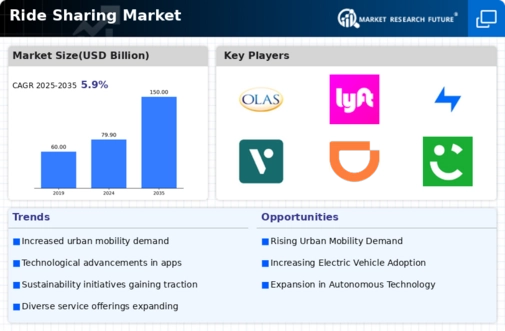Market Trends
Introduction
By the time we enter 2024, the Ride-Hailing Industry is undergoing major changes, driven by a confluence of macro-level factors. Artificial intelligence and mobile applications are reshaping the customer experience and operational efficiency. Regulators are tightening their grip, forcing companies to adapt to new compliance and safety standards. In addition, changes in consumer preferences for sustainable and convenient transportation are reshaping the market. These trends are strategically important for companies and their investors. They not only help them to position themselves in the marketplace, but also to shape their investment strategies and operational changes.
Top Trends
-
Increased Adoption of Electric Vehicles
Electric cars are being introduced into the fleets of taxi companies, mainly because of government subsidies and regulations. For example, California has a goal of selling only zero-emission vehicles by 2035. This switch not only reduces carbon emissions, but also lowers operating costs because EVs are less expensive to maintain. If more cities adopt zero-emissions regulations, ride-hailing services will be forced to go electric. -
Expansion of Micro-Mobility Solutions
The rise of micro-mobility, such as e-scooters and bicycles, is reshaping urban transport. These services are being offered by companies such as Lyft and Grab, which are focusing on short-distance mobility. In some cities, the use of micro-mobility is reducing congestion by up to 15 per cent. As cities develop micro-mobility, ride-hailing services will become more attractive. -
Integration of AI and Machine Learning
The application of artificial intelligence to ride-hailing services is becoming an indispensable tool for managing dynamic prices and routes. The demand for the service is constantly changing, and the application of artificial intelligence can be used to predict the demand for the service, which can improve the efficiency and quality of the service. For example, Uber's artificial intelligence system allegedly reduced the waiting time for users by 20%. As the technology develops, the reliance on artificial intelligence will be greater, and the personalization and efficiency of the service will be further improved. -
Focus on Safety and Security Enhancements
Security is the major concern of the ride-hailing industry, which has prompted the companies to implement a number of advanced safety features. The emergency button in the app and background checks on drivers are becoming the norm. According to a survey, more than 70 percent of passengers put safety as their top priority when choosing a ride-hailing service. As passenger expectations increase, ride-hailing companies are likely to invest more in safety technology, which could in turn influence their customer retention and brand loyalty. -
Rise of Subscription-Based Models
Subscriptions are gaining ground in the ride-hailing market. They offer predictability and convenience. Companies like Lyft are testing monthly plans that offer a set number of rides. Subscriptions can increase ridership by as much as 30 percent. This shift in customer behavior could change the way companies make money. -
Partnerships with Public Transportation
The fares for a trip by public transport and a trip by private means of transport are increasing. In San Francisco, for example, some associations have integrated the car-sharing with the bus schedules. These combinations, according to studies, increase the use of public transport by 10 percent. This direction is to continue, making access to cities more comfortable and reducing congestion. -
Emphasis on Sustainability and Corporate Responsibility
In addition, the environmental protection policy of these companies is becoming a major part of their business strategy. For example, the company Uber has declared that it will be a zero-emission platform by 2040. And this is because the consumers' demand for sustainable companies is growing: 65% of consumers prefer companies with a sustainable policy. This trend will certainly lead to the development of innovations in the field of sustainable development and will affect the strategy of companies. -
Enhanced User Experience through Technology
The technological advances have significantly improved the ride-sharing experience. A lot of the services are now on a par with those of cabs. The in-app chat, the location tracking, and the cashless payment are becoming a standard. The statistics show that 80% of the users prefer the intuitive and easy-to-use interface. The competition will make the companies continue to evolve their platforms to meet the evolving needs of the users. This will possibly lead to increased market share. -
Growth of Long-Distance Ride Sharing
Long-distance ride-sharing is emerging as a viable alternative to the old modes of transportation. This is where companies like BlaBlaCar come in, offering inexpensive ways to get from one city to another. Studies show that ride-sharing for long-distance travel can save up to 50%. It is a sector which is likely to grow, especially since consumers are looking for cheaper ways to travel. -
Increased Regulatory Scrutiny
As the market matures, regulatory scrutiny is growing, and governments are tightening their regulations. Some cities, for example, have begun to introduce regulations on driver qualifications and fares. A survey found that 60% of ride-hailing companies expected compliance costs to rise. This trend could lead to changes in operations and, consequently, to fares as companies adjust to the changing regulatory environment.
Conclusion: Navigating the Competitive Ride Sharing Landscape
The ride-hailing market in 2024 is characterised by a high degree of competition and fragmentation, with a number of large and small companies vying for a share of the market. Regional trends show a growing preference for localised services, and the companies are increasingly tailoring their offerings to meet local needs. The established players are relying on their well-known brand names and their economies of scale, while the newcomers are focusing on innovation and niche markets. The key factors in the race for market leadership will be the use of artificial intelligence, automation, sustainable initiatives and flexible service offerings. Strategic investment in these areas is crucial for companies that want to keep up with the development of the market and meet changing customer expectations.

















Leave a Comment